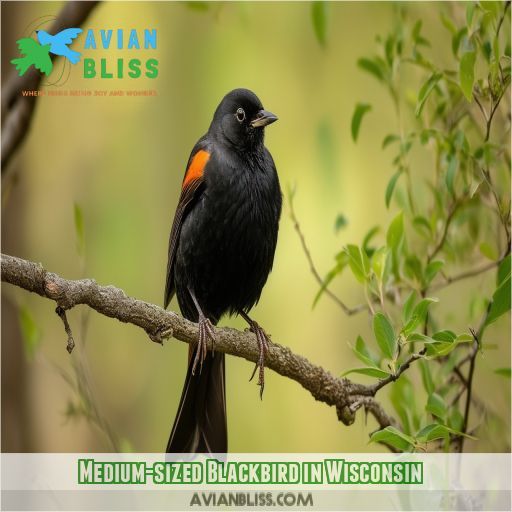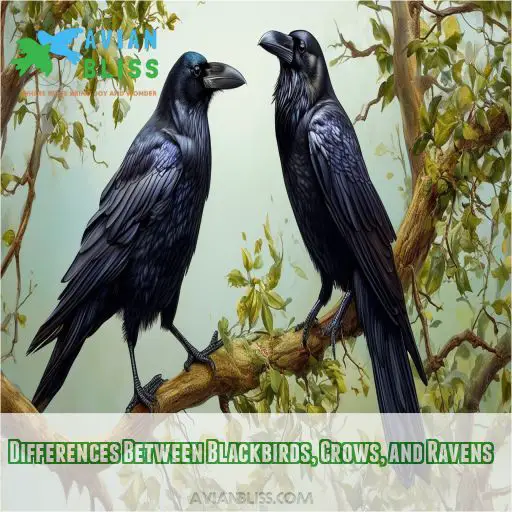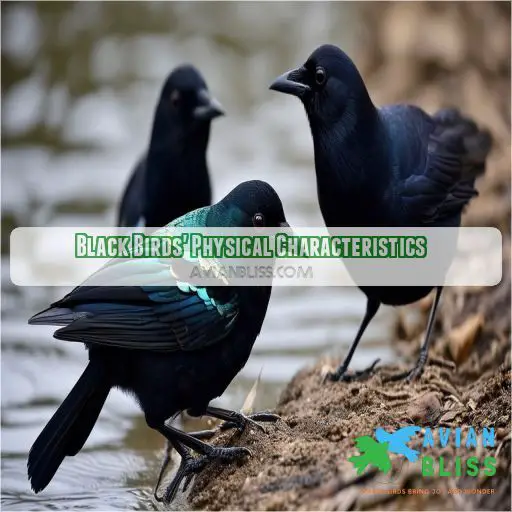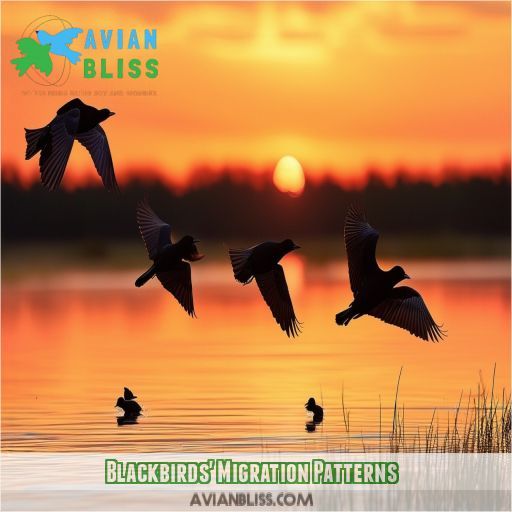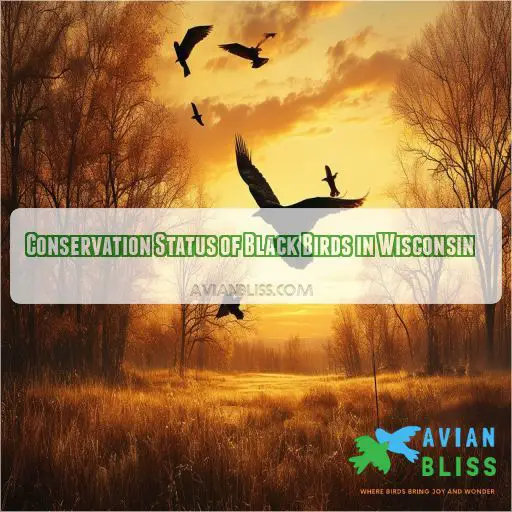This site is supported by our readers. We may earn a commission, at no cost to you, if you purchase through links.
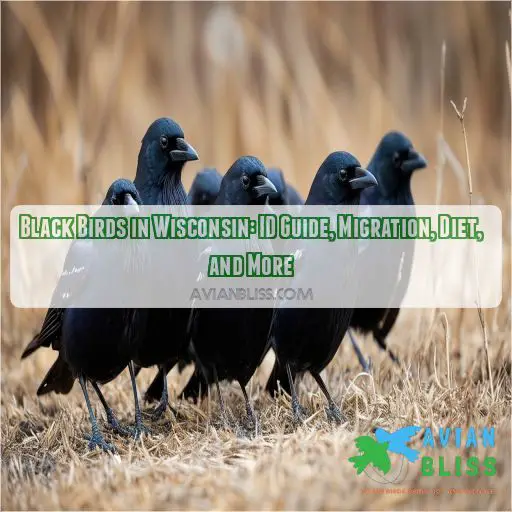
You’re in the right place to master identifying black birds in Wisconsin. This guide covers everything from common species and physical characteristics to migration patterns and diets.
Whether distinguishing between blackbirds, crows, and ravens or exploring specific nesting habits, you’ll gain the insights needed to confidently identify and understand these fascinating creatures in their natural habitats.
Table Of Contents
- Key Takeaways
- Common Black Birds in Wisconsin
- Medium-sized Blackbird in Wisconsin
- Differences Between Blackbirds, Crows, and Ravens
- Other Unique Black Birds in Wisconsin
- Black Birds’ Physical Characteristics
- Female and Juvenile Blackbird Variations
- Blackbirds’ Diet and Feeding Habits
- Blackbirds’ Migration Patterns
- Nesting Habits of Blackbirds
- Conservation Status of Black Birds in Wisconsin
- Frequently Asked Questions (FAQs)
- Which is a common black bird?
- What is a medium size blackbird in Wisconsin?
- Is a blackbird the same as a crow or raven?
- Are there other black birds besides crows?
- What are the most common black birds in Wisconsin?
- What are some unique black birds found in the state?
- How do black birds diets vary?
- Do black birds migrate?
- What are black birds nesting habits?
- Conclusion
Key Takeaways
- Delve into the world of Wisconsin’s blackbirds, from the common to the unique, and learn to spot their distinct characteristics.
- Discover the fascinating nesting habits of blackbirds, including their clever colony strategy and choice of nesting sites near water.
- Stay up to date on the conservation status of blackbirds in Wisconsin and learn how to support their well-being.
- Expand your birdwatching skills by identifying the Rusty Blackbird, Yellow-headed Blackbird, Baltimore Oriole, and other intriguing species that grace the state.
Common Black Birds in Wisconsin
If you’re a birdwatcher in Wisconsin, you’ll likely spot some common black birds. These include the red-winged blackbird, common grackle, brown-headed cowbird, European starling, and downy woodpecker.
The red-winged blackbird is easily recognizable by its black body and red and yellow shoulder patches.
The common grackle is larger than a robin with iridescent black feathers and a long, keel-shaped tail.
As for the brown-headed cowbird, females resemble large sparrows with a brownish color.
Keep an eye out for these common birds, and you’ll soon be able to identify them with ease.
Medium-sized Blackbird in Wisconsin
If you’re spotting medium-sized blackbirds in Wisconsin, chances are you’re observing the common grackle or the Brewer’s blackbird. These birds are larger than a robin with a glossy, iridescent black hue. The common grackle has a long, keel-shaped tail and a blue or purple head, while the Brewer’s blackbird has a round head and dark eyes.
These birds are social and often gather in large flocks, displaying aggressive behavior to scare away smaller birds. Their songs and calls vary, with the common grackle producing a variety of sounds, and the Brewer’s blackbird having a more limited repertoire.
These medium-sized blackbirds are adaptable and can be found in a range of habitats, from farmyards to towns, showcasing their ability to thrive in diverse environments.
Differences Between Blackbirds, Crows, and Ravens
While blackbirds, crows, and ravens may all appear similar at first glance, there are several key differences to help you distinguish between them:
- Physical Differences: Crows and ravens are generally larger than blackbirds, often with more robust bodies and longer tails. Ravens tend to be the largest of the three, appearing more massive and heavy-set.
- Vocal Differences: Blackbirds have a varied song repertoire, including whistles, clicks, and buzzes. In contrast, crows and ravens have deeper, more guttural calls, often consisting of caws and croaks.
- Habitat Preferences: Blackbirds are highly adaptable and can be found in a wide range of habitats, from open fields to urban areas. Crows and ravens, on the other hand, prefer more open spaces, such as fields, forests, and coastal areas.
Keep an eye and ear out for these distinct features as you explore the diverse bird life in Wisconsin.
Other Unique Black Birds in Wisconsin
Now that we’ve covered the differences between blackbirds, crows, and ravens, let’s turn our attention to some of the other unique black birds that call Wisconsin home.
First on our list is the Common Raven. This large, intelligent bird is easily distinguished from the American Crow by its larger size, shaggy throat feathers, and wedge-shaped tail. You might catch one playing with objects or creating its own toys, as ravens are known for their playful nature.
Next up is the Yellow-headed Blackbird, often found in the western parts of Wisconsin, especially near marshes and wetlands. This species stands out with its bright yellow head and breast contrasting against a black body and wings.
Another unique bird experiencing a decline in Wisconsin is the Rusty Blackbird. Its population, once common, has seen a dramatic decrease for unknown reasons, leaving ornithologists puzzled.
While not entirely black, the male Baltimore Oriole deserves a mention for its vibrant orange breast, making it a colorful addition to Wisconsin’s avian community. These birds are attracted to orange and nectar, so keep an eye out for them near fruit-bearing trees or nectar-producing flowers.
Black Birds’ Physical Characteristics
As you traverse Wisconsin’s varied landscapes, observe these distinctive characteristics that differentiate blackbirds within the avian realm:
- Size and Shape: Blackbirds vary in size, from the petite female grackles to the imposing wingspan of the turkey vulture. Their bodies may be slender or robust, with tails ranging from long and keel-shaped to broad and fan-shaped.
- Color and Feathers: The color black is their hallmark, but it’s not mere black. Their feathers often possess a glossy, iridescent sheen, with hints of blue, purple, or bronze. This unique coloration lends them an enigmatic and elegant appearance.
- Flight and Movement: Blackbirds are adept fliers, capable of soaring, gliding, and maneuvering with ease. Some species, like the common grackle, are renowned for their impressive flight displays, gathering in vast flocks to fill the sky with their graceful movements.
- Song and Call: Their vocalizations vary, from the assertive "conk-la-ree!" to mesmerizing murmurations in flight. Each species has its own unique song and call, adding a layer of aural intrigue to their presence.
- Habitat and Behavior: Blackbirds are adaptable, making their homes in a variety of habitats, including near water, in fields, marshes, towns, or even your backyard. Their behavior ranges from aggressive to parasitic, always keeping things interesting.
Whether you’re a birdwatcher, a nature enthusiast, or simply someone who appreciates the beauty of these feathered companions, blackbirds offer a compelling glimpse into the natural world that surrounds us.
Female and Juvenile Blackbird Variations
Female and juvenile blackbirds exhibit notable variations in appearance and behavior, which can aid in bird identification and enhance your birdwatching experience.
Female grackles, for instance, are smaller than their male counterparts and sport duller plumage. The great-tailed grackle, in particular, showcases this dimorphism with its dark brown upper body, lighter brown chest, and prominent light brown eyebrow. Juvenile grackles also stand out with their brown feathers and dark eyes, making them easily distinguishable from adults.
These variations in plumage and size reflect the intricate life cycle and habitat preferences of blackbirds. They also contribute to the fascinating behavior variations observed within blackbird species, showcasing the remarkable adaptability and diversity of these avian wonders.
Blackbirds’ Diet and Feeding Habits
Now that you can identify female and juvenile blackbirds, let’s examine their diet and feeding habits. Blackbirds are omnivores, and their diet varies depending on the season and region. Here are some of their common food sources:
- Grain and Seeds: Cracked corn, sunflower seeds, and peanuts are among their favorite treats.
- Suet: Blackbirds also enjoy suet, which is a hard fat often used in bird feeders.
- Insects: Insects form an essential part of their diet, especially during the warmer months.
- Berries: Blackbirds relish berries and will feast on them when available.
Blackbirds are opportunistic feeders and will adapt their diet based on what’s accessible in their environment. They’re known to frequent bird feeders, especially those offering their preferred seeds. Keep an eye out for these feathery foragers at your feeders, and you might just spot some interesting feeding behaviors!
Blackbirds’ Migration Patterns
Blackbirds’ migration patterns in Wisconsin vary depending on the species. Some blackbirds, like the red-winged blackbird, are found year-round in most of the United States, while others migrate short distances for the winter.
Banding studies and birdwatching apps can provide insights into the migration routes and wintering locations of these birds. These tools help track their long-distance flights and understand any historical changes in their migration patterns.
Nesting Habits of Blackbirds
Blackbirds in Wisconsin have some interesting nesting habits. The female Blackbird takes charge of nest-building, often choosing conifer trees near water as their nesting site. These birds are social nesters, gathering in large colonies to raise their young together. This safety-in-numbers strategy may be one reason why Blackbirds prefer nesting near water, as it provides an additional layer of protection from predators.
The size of these Blackbird colonies can vary, but they often consist of several dozen pairs of birds. Each pair defends their nest vigorously, ensuring that their young have the best chance of survival. Blackbird nests are typically constructed from materials readily available in their environment, such as twigs, grass, and leaves.
Blackbirds’ nests are often targeted by predators like the Pileated Woodpecker, so it’s essential for them to choose safe locations and build sturdy nests. While nest predation rates can vary, Blackbirds’ defensive strategies and site selection play a critical role in keeping their young safe.
If you’re interested in bird photography or simply observing these nesting habits, remember to maintain a respectful distance, as disturbing active nests can have detrimental effects on Blackbird colonies.
Conservation Status of Black Birds in Wisconsin
Now that you’re acquainted with the nesting habits of blackbirds, let’s shift our attention to their conservation status in Wisconsin. This topic is critical, as it guarantees the ongoing existence of these fascinating birds in the state. Here’s what you need to know:
- Legal Status: In Wisconsin, black birds are protected under the Federal Migratory Bird Treaty Act. This means that they can only be killed when causing damage or posing a health hazard. However, specific states may enforce more stringent regulations on killing these birds.
- Population Trends: While black birds are generally common in Wisconsin, certain species like the Rusty Blackbird have experienced a mysterious decline in population. Monitoring these trends is essential for targeted conservation efforts.
- Conservation Efforts: Various strategies are employed to protect black birds in Wisconsin. These include exclusion methods, such as using netting to prevent birds from accessing small plots, and cultural methods, like deep planting and providing alternative feeding sites. Additionally, organizations like the Cornell Lab of Ornithology play a key role in research and education, fostering a better understanding of black bird conservation needs.
Frequently Asked Questions (FAQs)
Which is a common black bird?
The common blackbird, also known as the Eurasian blackbird, is a species of true thrush. It has a range of around 4 million square kilometres and a large population, including an estimated 79 to 160 million individuals in Europe.
What is a medium size blackbird in Wisconsin?
The Rusty Blackbird is a medium-sized blackbird found in Wisconsin. Breeding males are entirely glossy black, while non-breeding males are a duller black with rusty-brown edging. They’re about the same size as a Red-Winged Blackbird or Northern Cardinal.
Is a blackbird the same as a crow or raven?
No, blackbirds are smaller and have longer tails than crows and ravens. They’re also in a different avian family, with a more insect-based diet.
Are there other black birds besides crows?
Yes, there are several other black birds besides crows, including common grackles, European starlings, and brown-headed cowbirds.
What are the most common black birds in Wisconsin?
The most common black birds in Wisconsin are the Red-Winged Blackbird and the Common Grackle. Red-winged blackbirds are found in marshes, roadsides, meadows, and crop fields.
What are some unique black birds found in the state?
You’ll find a variety of unique black birds in Wisconsin, including the Common Raven, Yellow-headed Blackbird, Rusty Blackbird, Pileated Woodpecker, and Baltimore Oriole.
How do black birds diets vary?
Blackbirds are omnivores with diets that vary by season. In the winter, they eat fruits, berries, seeds, and insects. In the summer, they prefer earthworms and caterpillars. They also enjoy fatty, processed foods like fried bread and dog food.
Do black birds migrate?
Blackbirds migrate at night and during the day, usually in autumn. Northern blackbirds migrate south for winter, while southern blackbirds are year-round residents.
What are black birds nesting habits?
You might be surprised to learn that blackbirds have a unique "get-in, get-out" approach to nesting and raising their young. They like to nest low to the ground in shrubs, climbing plants, and small trees, sometimes even on the ground. They build their nests with twigs, grass, straw, and mud.
Conclusion
Now that you’ve completed this extensive guide, you’re well-prepared to identify and appreciate the distinctive traits of black birds in Wisconsin.
You can differentiate between common types, recognize physical attributes, and even understand their migration patterns and diets.
Whether you’re an avid birdwatcher or a curious nature enthusiast, you now have the knowledge to enjoy the beauty and variety of these feathered companions in their natural habitat.


